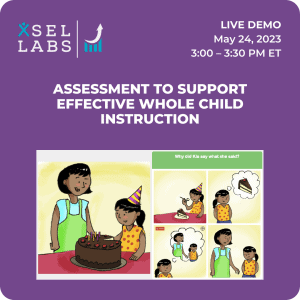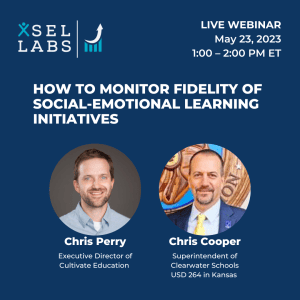When you boil it down, an educational test is a sample of student response that is evaluated to make a judgment about a child’s academic strengths and needs. To test reading fluency, for example, a child reads a passage out loud (student response), the tester records the child’s reading speed and accuracy (evaluation), and that speed and accuracy is converted to a score that can be readily interpreted in terms, say, of the relationship between the child’s performance and expected reading fluency for her age (judgment). Achievement tests, in general, do an excellent job of helping educators understand student strengths and needs so they can build on student strengths and address student needs.
More and more, educators are coming to embrace the importance of supporting student social-emotional learning because of its clear effect on student success in school and life. For educators who want to support student SEL as intentionally as they support student mastery of academic success, assessment has an important role to play to clarify student strengths and needs so that educators can build on student strengths and address student needs.
But academic skills and SEL are different from one another. On a math test, there are right and wrong answers that provide insight into student math skills. Are there right and wrong ways to “do” SEL? It turns out, that the answer is mostly yes, and the ways of assessing SEL skills can look a lot like achievement tests. But they don’t always.
Direct versus Survey Assessments
There are two kinds of SEL assessments—“show” assessments and “tell” assessments. Like the reading fluency test described above, both kinds of assessment involve sampling behaviors that are evaluated to make a judgment about a child’s skill level. With “show” assessments, also called “direct assessment,” children solve challenging problems that have right and wrong answers and in so doing, directly demonstrate their skill level, a lot like the reading fluency test. For example, children might look at pictures of people and indicate what they feel from their facial expressions or body posture. Or they might play a game-like task that assesses their self-control.
With “tell” assessments, a rater, typically the child or her teacher, rates a series of statements on a survey that may reflect social-emotional skills. In self-report “tell” assessments, children rate their own skill levels. For example, a child might rate how true, on a scale from one to four, statements like, “I’m good at making friends.” Or a teacher might rate the frequency of behaviors reflecting social-emotional skills. For example, a teacher might rate how frequently, on a scale from one to four, a child engages in behaviors like, “Compromises well.”
Each kind of assessment has its proper place in understanding student SEL skills. Show assessments are well-suited to measuring social-emotional comprehension, or the mental skills children apply to encode, interpret, and reason about social and emotional information. This includes things like recognizing others’ emotions and perspectives, solving social problems, and (some aspects of) self-control. Tell assessments, particularly teacher rating scales are well-suited to measuring social-emotional execution, which involves the observable behavior children engage in when they interact with others. Self-report questionnaires are well-suited to measuring children’s attitudes and beliefs.
Match your Assessment to What You Want to Measure
Like the children, these assessments are intended to assess, and each of these methods has strengths and weaknesses. The important thing for educators is to choose the SEL assessment that is best suited to measuring what you think is most important. In fact, combining assessment methods can provide powerful insights that are impossible when using one method exclusively.
To see an example of a “show” assessment, check out our direct SEL measure.



